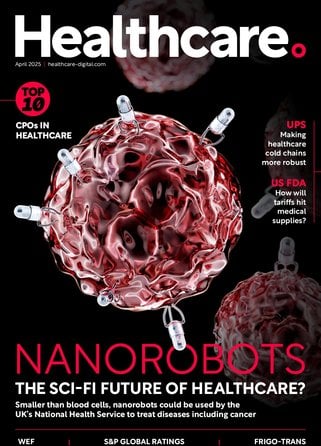Smart Hospitals: Digitalising Healthcare for a new era

There are very few places in the world that elicit the same reaction from the majority of people who come through the door. Your pulse accelerates, your palms feel clammy, your heartbeat magically moves from your chest right into your throat. Most of us dislike going to hospital to say the least; and yet, there are very few places in the world that we have such high expectations of.
We expect to see a doctor or a nurse quickly, we expect them to have the right diagnostic equipment at hand, and we expect operating theaters and beds to be available when we need them – in short, we expect nothing less than the highest quality of care.
For hospitals hit hard by the global pandemic, under pressure to cut costs and make operations more sustainable, this is an ideal that has become a bit like the holy grail. It’s out there – but the reality that administrators and medical staff face in today’s healthcare sector can make achieving this goal for every patient somewhat elusive. Before we get to what we can do to fix this, we’ll take a quick look at the why.
Let’s start with the sum of all of us. It’s growing, disproportionately. By 2050, the World Health Organization (WHO) estimates that the world population of people aged 60 years and older will double to 2.1 billion. The number of persons aged 80 years or older is expected to triple between 2020 and 2050 to reach 426 million. If things go to plan, I’ll be one of them by 2050.
An ageing population will create much greater demands for our healthcare systems. Systems that are already in crisis. Many hospitals already report an operating loss, with high energy costs and inflation wreaking havoc on their finances.
At the same time, the WHO expects the shortage in the global healthcare workforce to reach 10 million workers by 2030. Medical professionals who choose to stay work in ageing buildings, where they walk a daily tightrope of balancing higher patient expectations with inefficient processes and cost pressures, in a constant battle to spend more time doing what they love: treating people like you and me.
Digitalization: A light at the end of the tunnel
Amidst this gloomy outlook, digital technologies are creating a window of opportunity for the healthcare sector. Faced with the imperative to maximize operational efficiency, retain staff and become more sustainable, digitalization can help hospitals make the most of their available resources.
In many places it’s an uphill climb. A 2023 OECD report highlights that OECD countries are struggling to maximize the value from digital health because technologies and the data environment are often outdated and fragmented. At Siemens, we have been working with partners across the world to address these challenges.
One of the keys to unlocking the potential that digitalization holds for hospitals is combining the real and the digital worlds – using software on digital business platforms such as Siemens Xcelerator to transform operations.
Automating to advance integrated building operations
Often, the data is already there. But it’s stuck in silos that don’t communicate with each other. In Switzerland, we worked on a pilot project with the hospital group Insel Gruppe to change this. By combining a digital twin of the hospital from the building information modelling software and data from our own building management platform, Insel Gruppe could understand, assess and optimize operations in future projects based on this existing use case.
But what if the building is already there? How do we smarten up this kind of asset? Ankara City Hospital is a prime example. As one of the world’s biggest hospitals, it comprises a vast campus with hundreds of thousands of data points. Ankara City Hospital partnered with Siemens to integrate them into one building management platform. It monitors and controls 22 hospital subsystems run by various operators, as well as 800,000 data points, enabling the hospital’s infrastructure to run smoothly.
Research from the Siemens Infrastructure Transition Monitor suggests that this is the kind of transformation we could see more of in the future, with 38 percent of respondents saying data driven management systems were a budget priority.
Customers are increasingly focused on maximizing existing resources. And as the project with Ankara City Hospital shows, retrofitting existing buildings with advanced technology has become both feasible and cost-effective. But how do we improve processes and maximize efficiency for the people who work in these buildings?
Boosting the efficiency of hospital workflows
For healthcare workers, inefficient work processes are one of the biggest headaches of their job. Nurses, for example, spend an average of 72 minutes looking for equipment, every shift. That’s six hours per week, 24 hours per month! Time that they would prefer to spend taking care of patients.
In a new partnership with the Swiss hospital Kantonsspital Baden, Siemens is developing an app for real-time location services to help staff find medical equipment.
It will also include a navigation system which will make it easier for patients and staff to find their way around the hospital campus. This app is one of the first use cases born from what is the brain of digitalizing processes and workflows: a new demand-driven, customized Internet of Things (IoT) platform.
Ours is from our digital business platform Siemens Xcelerator and will help the hospital manage data from more than 2,000 asset tags and 7,000 IoT sensors.
It’s the foundation for developing and scaling use cases for future tasks – ensuring user-centric patient experience, improved patient care, increased energy efficiency, and optimized operations. These efforts are a great start to our partnership’s goal to create one of Switzerland’s first smart hospitals.
Addressing healthcare’s carbon footprint
But intelligent apps and integrated technology systems are only one side of the coin when it comes to imagining smart hospitals – they must also be sustainable. The status quo on that front is shocking. The climate footprint of healthcare is equivalent to 4.6 percent of worldwide CO2 emissions. That’s more than shipping and aviation put together. If it were a country, healthcare would be the fifth largest emitter on the planet.
This needs to change. But cleaning up a hospital’s carbon footprint is less straightforward than you might think. Hospitals can use twice the power of the average commercial building. One of the main factors is that they are full of power-intensive equipment and systems – imaging equipment is among the worst offenders.
Critical to catching diseases early, imaging machinery saves lives every day. But in doing so, a single MRI unit can consume as much energy as 12 US homes. In a partnership between Siemens, Siemens Healthineers, and the University of California, San Francisco, we explored what could be done to reduce energy consumption, costs and carbon emissions from MRI machine operations.
Greener radiology: Have you tried turning it off and on again?
We found that even small measures, such as putting MRI machines into the lowest power mode when not in use, could have a big impact. Turning MRIs off overnight for 12 hours reduced energy usage by 25 to 33 percent. Enabling an additional “power save” mode, a novel energy feature in Siemens Healthineers’ newer MRI scanners, while the machine was off decreased power use by an additional 22 to 28 percent.
These are just a few examples of how small changes can go a long way in the pursuit of the highest quality of care. And maybe one day, when we walk through hospital doors, our palms will stay dry, our heartbeat will stay in our chest, and we will stay calm.
Because we know that we have just entered a place where people, intelligent software solutions and smart infrastructure work hand in hand to create a safety net where nobody will fall through the cracks. With the help of digital technologies, I believe this can happen. I believe it will.
- AI, Ozempic & Recruitment: This Week's Healthcare StoriesTechnology & AI
- Augmented Reality can Transform Hospital Infection TrainingTechnology & AI
- How DeepHealth is Using AI to Screen for Breast CancerTechnology & AI
- How can AI Transform Recruiting in the Healthcare Sector?Technology & AI



